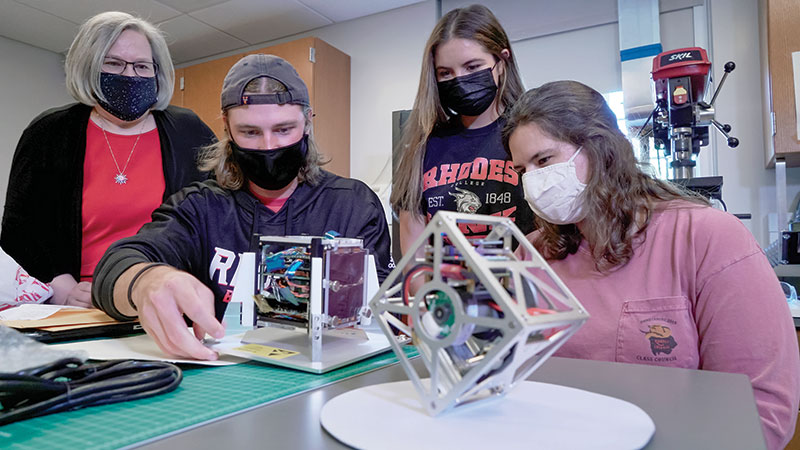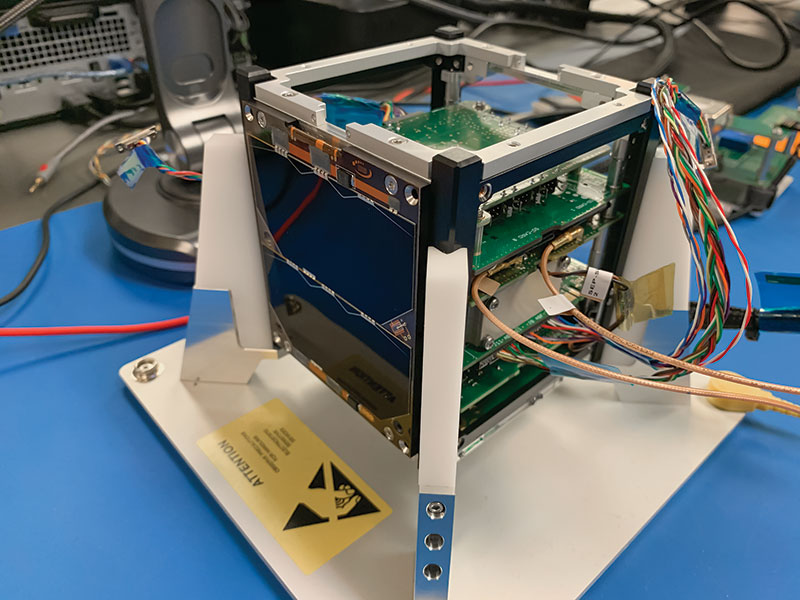From Brainstorming to Building a Satellite for Space
Winter
2022
Feature
From Brainstorming to Building a Satellite for Space
Benjamin Wilson, SPS Member, Rhodes College
 Have you ever wondered what it would be like to build a satellite without the support of an engineering program? Well, that’s what the Rhodes College CubeSat team is doing! Utilizing our team’s various skills, we’re putting together a CubeSat that will eventually launch into space aboard a NASA rocket.
Have you ever wondered what it would be like to build a satellite without the support of an engineering program? Well, that’s what the Rhodes College CubeSat team is doing! Utilizing our team’s various skills, we’re putting together a CubeSat that will eventually launch into space aboard a NASA rocket.
CubeSats are four-inch-cube satellites that test developmental technology in space. They’re becoming increasingly popular, as their small size and relatively low cost have made space more accessible to smaller research teams and institutions.
Our mission, dubbed RHOK-SAT, is a collaboration between Rhodes College and the University of Oklahoma. The mission’s educational objective is to provide a technology-intensive experience for students attending a liberal arts institution, which describes our team at Rhodes. Its scientific objective is to test the space hardiness of perovskite solar cells. That’s where the University of Oklahoma comes in. RHOK-SAT will be one of the first missions to test solar cells of this type. We hope to show that they are viable candidates for powering future space missions.
There are about ten students on the Rhodes team, with additional students planning to join this spring. Most are physics and computer science majors, and all of the physics majors are part of SPS.
Thinking big
As undergraduate students with limited technical knowledge, the idea of building a satellite seemed far-fetched at first. Friends didn’t even believe us when we first told them our goal!
We decided to build a CubeSat in 2019, after our department received a financial gift to support research. Our first question was, “Where do we start?” We began by brainstorming a mission. We considered everything from space debris detection to deforestation tracking. After some time we met the Photovoltaic Materials and Devices Group at the University of Oklahoma and heard about their solar cell research. We decided to work with them to test novel solar cell technology and its potential to power future space missions.
After deciding on a mission, our next task was simple. Build a satellite.
Eyes and ears to the sky
Over the summer of 2020, our team members worked on the project from home. We learned how radio antennas work, how satellites are tracked in orbit, and how to program microcontrollers for solar cell data acquisition. Using satellite tracking software and homemade antennas, we stood on our roofs and listened to satellites passing overhead. In order to communicate with our satellite by radio, we needed to get HAM radio operator’s licenses. We’ve since constructed our own ground station on campus to talk with the satellite.
In fall 2020 we submitted a proposal for consideration by NASA’s CubeSat Launch Initiative (CSLI). The initiative provides universities, high schools, and nonprofit organizations with the opportunity to fly a small satellite payload on an upcoming launch. With the help of advisors and reviewers from various scientific backgrounds, we outlined our project and its relevance to the scientific community. In April 2021, RHOK-SAT was one of 14 small research satellites selected! This means RHOK-SAT will be launched by NASA on a rocket as an auxiliary payload, and NASA will cover all or most of the launch costs.
Our CubeSat will likely be in the cargo of a resupply or crew launch to the International Space Station (ISS), along with other CubeSats. Astronauts aboard the ISS will load the satellites into a launch tube and deploy them into orbit. Not all CubeSats are launched this way, however. Satellites that require specific orbit parameters, such as height above Earth or angle of flight relative to the equator, can be jettisoned directly from a rocket as it’s in the desired orbit.
Building for space
Teams that build satellites start by testing their ideas on an engineering model (EM) that does not go into space. Our EM is a replica of the satellite and we use it for hardware and software development. The EM also helps us test software updates before we send them up to space.
Our programming team is working with the EM to write custom flight software. This software ensures the correct operation of the satellite’s subsystems, collects data on the solar cells, and reports everything back to us on the ground. Each solar cell’s data is collected through a dedicated microcontroller. The on-board computer will run on a real-time operating system (RTOS). The RTOS runs normal operations, executes tests on the solar cells, and controls radio communications. If the system encounters a bug or malfunction, the RTOS can recognize it, stop the current command, and alert us before more problems arise.
As one of the first teams to send these solar cells into space, we’re facing new engineering challenges. As a result, we’ve learned how to design, print, and test custom hardware using 3D design software and 3D printers. To electrically connect to our test solar cells, we’ve designed printed circuit boards to fit exact specifications.
One of our current projects is sun sensor calibration. We only want to take solar cell measurements when the cells are pointing toward the sun, so we’re using a photodiode to track the angle between the sun and the satellite.
We’re also working on educational outreach. As part of our educational mission, we hope to spark interest in STEM fields among high school students. So we visit local high schools in Memphis, Tennessee, to teach them about our project, solar technology, and the effects of gravity in space.
We are about halfway through the project and aim to be ready for launch by June 2023. While we still have much to do, our experience so far has been priceless. We will be forever grateful for this opportunity and the connections we’ve made along the way. These experiences have challenged our perception of what’s possible—even if you don’t have an engineering department at your disposal.

Get Money for Chapter Research!
Rhodes College has received multiple SPS Chapter Research Awards to help support this project. SPS Chapter Research Awards financially support chapter research activities that are imaginative and likely to strengthen the SPS program. The awards of up to $2,000 are generously funded by donations from Sigma Pi Sigma members and friends of SPS. Applications are due November 15 each year. spsnational.org/awards/chapter-research
